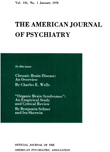PSYCHIATRIC APPRAISALS OF PARENTS AND SIBLINGS OF SCHIZOPHRENIC CHILDREN
Abstract
An attempt has been made to demonstrate the heuristic value of the concept etiological heterogeneity in investigations into the etiology of childhood schizophrenia. Emphasis has been put on the awareness possible varying mixtures of etiological factors including somatic deficit (acquired and/or genetic) and psychosocial factors. Stress has been placed on the need for techniques that adequately measure the subtler indications of neurological impairment in the children and the adequacy of the families' interaction with the children, in order to assess their relative roles in childhood schizophrenia.
The division of a group of schizophrenic children into a subgroup with signs and/or history suggestive of neurological impairment and a subgroup without such signs or history has been supported in previous studies done at the Ittleson Center. The findings supporting this kind of grouping included differences in many areas of ego functioning of the children, differences in the adequacy of the families, and differences in the maternal attitudes of the mothers. The validity of this subdivision is further supported in the present study by differences in the incidence of schizophrenia in the mothers of those 2 subgroups. There are twice as many mothers of the "nonorganic" subgroup diagnosed schizophrenic as there are mothers of the "organic" subgroup.
The importance of the psychosocial impact of families with schizophrenic parent(s) is underlined by the finding that families in which one or both parents are schizophrenic have a lower family adequacy rating than families without parental psychosis.
Access content
To read the fulltext, please use one of the options below to sign in or purchase access.- Personal login
- Institutional Login
- Sign in via OpenAthens
- Register for access
-
Please login/register if you wish to pair your device and check access availability.
Not a subscriber?
PsychiatryOnline subscription options offer access to the DSM-5 library, books, journals, CME, and patient resources. This all-in-one virtual library provides psychiatrists and mental health professionals with key resources for diagnosis, treatment, research, and professional development.
Need more help? PsychiatryOnline Customer Service may be reached by emailing [email protected] or by calling 800-368-5777 (in the U.S.) or 703-907-7322 (outside the U.S.).



